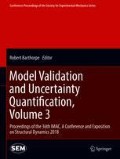Abstract
Experimental modal analysis typically use an actuator to apply input force on a structure and multiple fixed sensors to record the responses of the structure. An appealing alternative to using many stationary sensors is to use a roving actuator and a single fixed sensor. In this study, a method to identify the modal properties of a beam from the input-output data obtained using a roving actuator and a fixed accelerometer is presented. In multiple test setups, the roving actuator applies input forces at different points on the beam, while the fixed sensor measures the response at a particular location of the beam during all tests. Using the accumulated input-output measurements, the modal identification of the beam is performed in two distinct steps: identification of natural frequencies and modal damping ratios, followed by an estimation of mode shape components at all excited degrees of freedom. The variability in the estimated modal parameters due to the presence of measurement noise is studied using Monte Carlo simulations.
Access this chapter
Tax calculation will be finalised at checkout
Purchases are for personal use only
References
Cara, J., Juan, J., Alarcón, E.: Modal identification of structures from roving input data by means of maximum likelihood estimation of the state space model. In: Proceedings of the International Conference on Noise and Vibration Engineering – ISMA 2016 and International Conference on Uncertainty in Structural Dynamics – USD 2016, pp. 2923–2931 (2016)
Juang, J.N.: Applied System Identification. Prentice Hall, Englewood Cliffs (1994)
Marulanda, J., Caicedo, J.M., Thomson, P.: Modal identification using mobile sensors under ambient excitation. J. Comput. Civil Eng. 31(2), 04016051 (2016)
Matarazzo, T.J., Horner, M., Pakzad, S.N.: High-resolution mode shape identification using mobile sensors. In: Topics in Modal Analysis & Testing, pp. 255–260. Springer, Cham (2016)
Mukhopadhyay, S., Luş, H., Betti, R.: Modal parameter based structural identification using input–output data: minimal instrumentation and global identifiability issues. Mech. Syst. Signal Process. 45(2), 283–301 (2014)
Author information
Authors and Affiliations
Corresponding author
Editor information
Editors and Affiliations
Rights and permissions
Copyright information
© 2019 The Society for Experimental Mechanics, Inc.
About this paper
Cite this paper
Nayek, R., Mukhopadhyay, S., Narasimhan, S. (2019). Modal Identification Using a Roving Actuator and a Fixed Sensor. In: Barthorpe, R. (eds) Model Validation and Uncertainty Quantification, Volume 3. Conference Proceedings of the Society for Experimental Mechanics Series. Springer, Cham. https://doi.org/10.1007/978-3-319-74793-4_12
Download citation
DOI: https://doi.org/10.1007/978-3-319-74793-4_12
Published:
Publisher Name: Springer, Cham
Print ISBN: 978-3-319-74792-7
Online ISBN: 978-3-319-74793-4
eBook Packages: EngineeringEngineering (R0)

